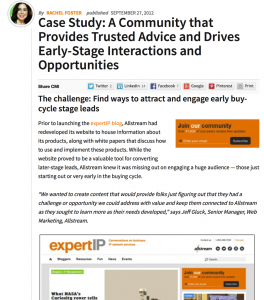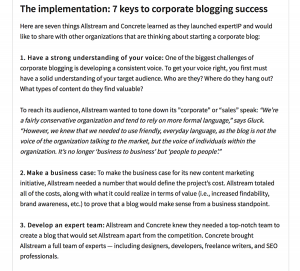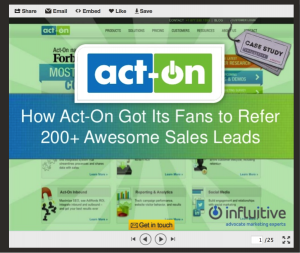Today’s B2B buyers are social.
They no longer immediately call a sales rep when they want to learn about a product. Instead, they search Google or tap their social networks for proof that a product delivers results.
Case studies are a great way to demonstrate this social proof.
A hawkeye study revealed that 71 percent of B2B buyers in the awareness stage and 77 percent in the evaluation stage of the sales cycle cited testimonials and case studies as the most influential types of content.
Since B2B buyers rely on case studies in multiple stages of the sales cycle, developing customer success stories should be at the top of your “to do” list.
A classic case study is a two-page customer success story that describes:
- The challenge your customer faced before she started working with you
- How your customer found you and why she selected you over other vendors
- The process of implementing your product
- Any results your customer achieved after she implemented your product
When I write a case study, I start with this format, as it allows me to get the complete story.
However, not everyone is going to read a classic case study. Some of your ideal customers may not have the time to read one or may prefer other types of content – such as audio or video. You’ll reach a wider audience if you repurpose your case studies for different channels.
Here are some alternatives to the classic case study that can help you get more ROI from your content:
The “How-To” Case Study
This type of case study is a cross between a “how-to” article and a customer success story. It works well on blogs, as many readers find blog posts when they look for information on how to solve a problem.
A “how-to” case study starts by describing your customer’s key challenges and how she found you. However, the implementation section is replaced by a list of tips. These tips can be advice from your customer that will help others who are dealing with the same situation. For example, your customer can address:
- The steps someone must take when implementing a similar solution
- What to know before starting the process
- The top five things to consider before purchasing a similar solution
- What someone can learn during the process
One of the reasons I like this format is because it’s presented as one customer giving advice to another. Here’s an example of a “how-to” case study.
The SlideShare Case Study
If your target audience is visual, you can connect with them by turning your case studies into presentations. Check out this example from Influitive to see what you can do with a SlideShare case study:
Here are some reasons why I like this example:
- Influitive uses a lot of images and minimal text. You don’t want to overload your slides with text, as it can make your story boring and difficult to read. Using bold images and a few great quotes from your customer works well for this format.
- The presentation is fun and engaging.
- Leads can opt in directly from the case study. One of the benefits of using SlideShare is that you can embed lead generation forms directly into your presentations. This feature is only available with SlideShare’s PRO plans, but it’s well worth it.
Related Class: Engagement Strategies: The Digital Customer Experience Case Study
The Mini Case Study
A mini case study can be a condensed version of a full case study or a customer testimonial. You can use them in the following places:
- Your website
- Emails
- Your social networks
- Brochures and sell sheets
- White papers and ebooks
- Direct mail pieces
- Your phone system’s “on hold” music
The “Customer’s Voice” Case Study
In this type of case study, your customer tells her story in her own words. Here are some examples:
- Your customer presents her case study at a conference
- You interview a customer during a podcast
- You create a video of a customer telling her story
Here’s an example of a great video case study from GoToMeeting:



